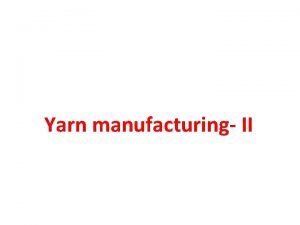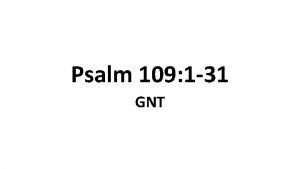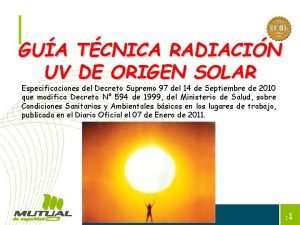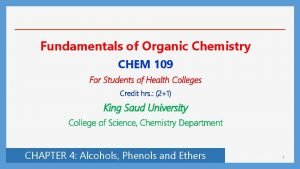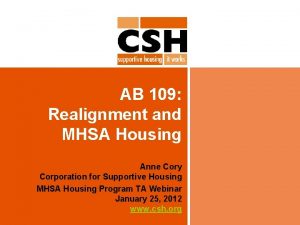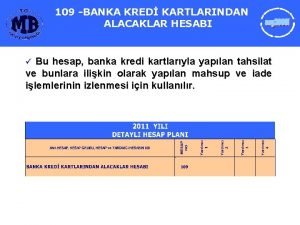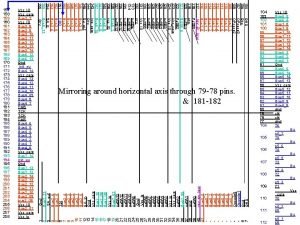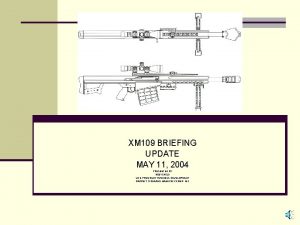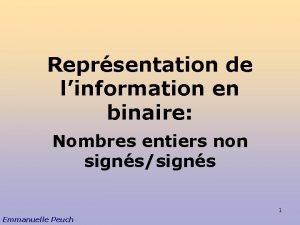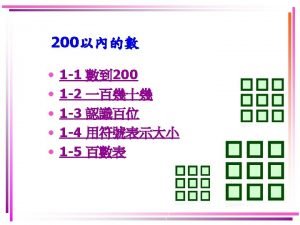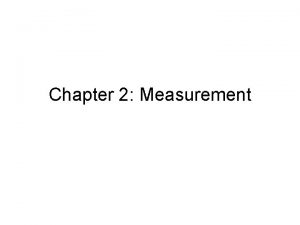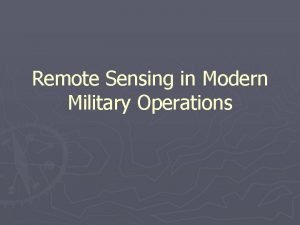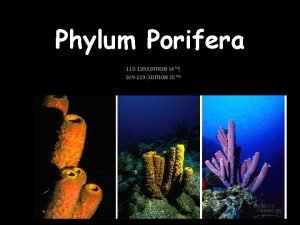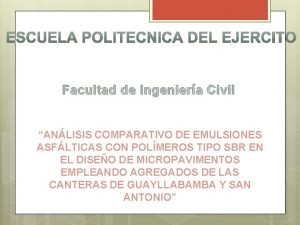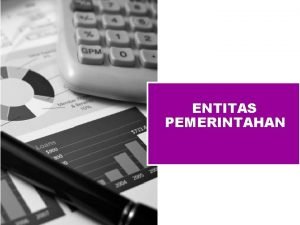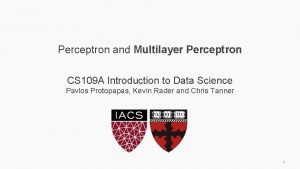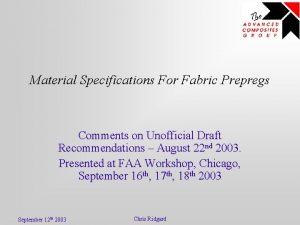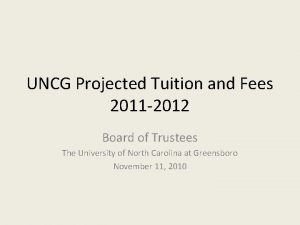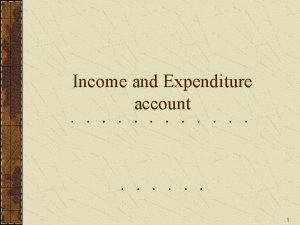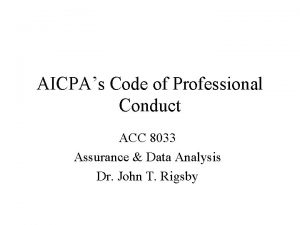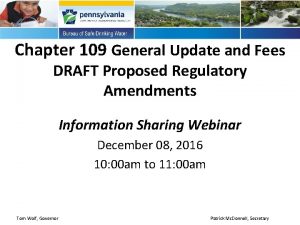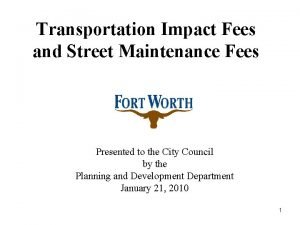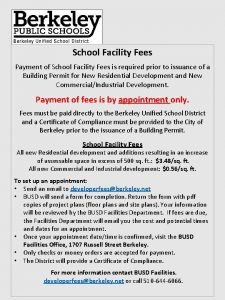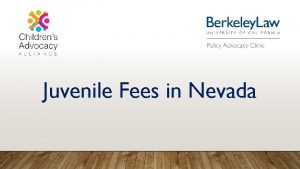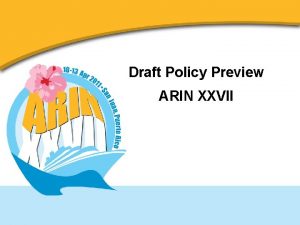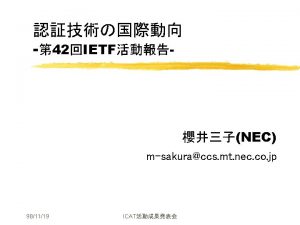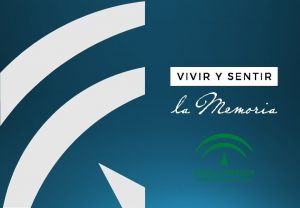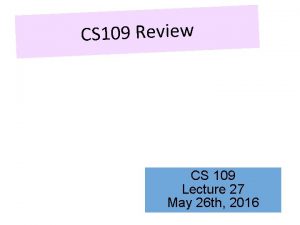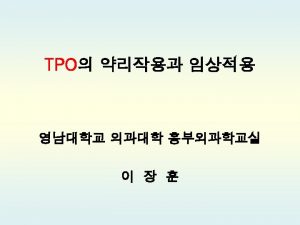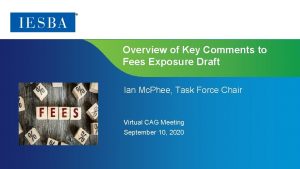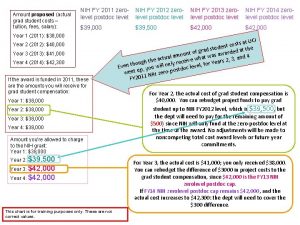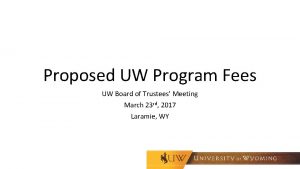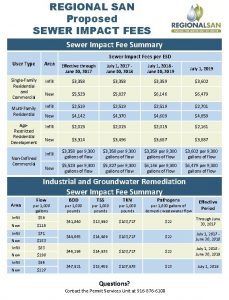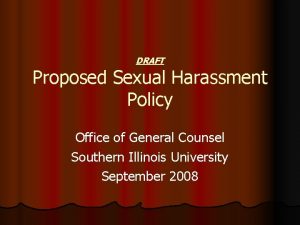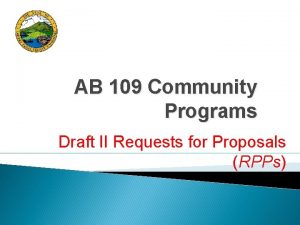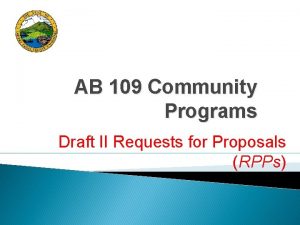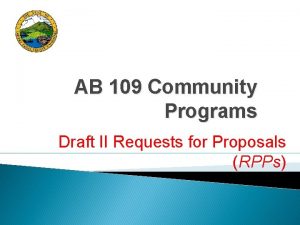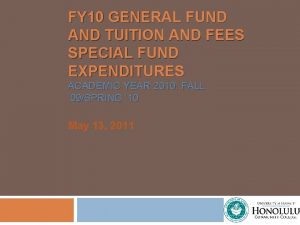Chapter 109 General Update and Fees DRAFT Proposed



























- Slides: 27

Chapter 109 General Update and Fees DRAFT Proposed Regulatory Amendments Information Sharing Webinar December 08, 2016 10: 00 am to 11: 00 am Tom Wolf, Governor Patrick Mc. Donnell, Secretary

Webinar Logistics • Please place your phones on mute • We will field questions after the presentation using the chat feature • One hour in duration • Webinar recording and Power. Point will be available on General Update website: – http: //tinyurl. com/109 update 2

Background and Purpose 1. Incorporate the remaining general update provisions that were separated from the previously proposed Revised Total Coliform Rule (RTCR) as directed by the EQB. 2. Establish new annual fees and amend existing permit fees. 3. Incorporate additional general updates that will: – Establish the regulatory basis for issuing general permits. – Clarify that noncommunity water systems (NCWS) require a permit or approval from DEP prior to construction or operation. – Address concerns related to gaps in monitoring and tracking of backup water sources and entry points.

Previously Proposed General Updates • Clarify Source Water Assessment & Protection Program Requirements: – Expand Well Head Protection Program to Source Water Protection Program, clarify inclusion of Surface Sources. – Include definitions related to SWP: Source Water Assessment, Source Water Protection Program, Surface Water Intake Protection Area and Surface Water Intake Protection Program – Require updated source water assessment by PWS if annual system evaluation identifies changes to potential sources of contamination.

Previously Proposed General Updates • Clarify New Source Sampling & Permitting Requirements: – The pre-drilling plan, source water assessment, and where necessary SWIP (Surface Water Identification Protocol) testing results must be included in application for construction permit. • This information was always required as per Public Water Supply (PWS) Design Manual & Permit Modules. – Make the existing process and expectations more transparent and easier to understand. – Thereby avoiding costly permitting delays for adding a new source.

Previously Proposed General Updates • Require auxiliary power or an alternate provision – finished water storage and interconnections: – Pennsylvania’s drinking water sources are susceptible to both natural and man-made disasters: • Tropical storms, flooding, high winds, ice, snow, • Transportation corridor spills impacting downstream users – Therefore, water systems must have effective options to provide consistent system service during such emergencies: • • Adequate auxiliary power Alternate provisions: finished water storage or interconnections

Previously Proposed General Updates • Revise permit requirements and design standards, and add new requirements for alarm and shutdown capabilities: – All surface water and GUDI filtration plants will need to be equipped with alarms. – If not staffed continuously, will also need shutdown capability. – Alarms and shutdowns will: • Be set at a level that results in compliance with applicable MCL’s MRDL’s and Treatment Techniques. • Include at minimum: IFE &CFE NTU, EP Cl 2 residual, clearwell levels. • Be capable of notifying the available operator on duty. • Be tested at least quarterly.

Previously Proposed General Updates • Revise treatment technique and turbidity performance requirements for pathogens: – Clarify requirement for continuous monitoring of CFE • Monitor and record no less frequently than once every 15 minutes the plant is in operation. • Failure in monitoring or recording equipment shall be fixed within 5 working days. – Establish specific performance requirements for CFE: • 0. 30 NTU for conventional or direct filtration technologies • 1. 0 NTU for slow sand Diatomaceous Earth (DE) filtration • 0. 15 NTU for membranes

Previously Proposed General Updates • Revise treatment technique and turbidity performance requirements for pathogens: – Lower IFE “trigger levels” to be consistent with CFE performance levels. – IFE levels which trigger initial corrective actions: • 0. 30 NTU for conventional or direct • 0. 15 NTU for membranes • 1. 0 NTU for slow sand or DE – Require continuous IFE monitoring/reporting for all filtration types.

Background and Purpose 1. Incorporate the remaining general update provisions that were separated from the proposed Revised Total Coliform Rule (RTCR) as ordered by the EQB. 2. Establish new annual fees and amend existing permit fees. 3. Incorporate additional general updates that will: – Establish the regulatory basis for issuing general permits. – Clarify that NCWSs require a permit or approval from DEP prior to construction or operation. – Address concerns related to gaps in monitoring and tracking of backup water sources and entry points.

Fees • DEP is seeking to fill the funding gap to ensure sufficient program capacity to protect public health, comply with existing environmental laws and regulations, and maintain primacy. • Fees are intended to cover ~ 50% of state costs or $7. 5 M. The remaining funds ($7. 7 M) will continue to come from the General Fund. • Fees will cover technical services; operations; program management, development and administration; and other state costs.

SDW Program Costs and Funding $4. 1 M $7. 7 M

New Annual Fees • At least 25 states charge annual fees including DE, NJ and VA. • Annual fees apply to all PWSs. • The proposed fees are intended to bear a reasonable relationship to the actual cost of providing services. • The fees also factor in affordability and equitability.

New Annual Fees for Several Mid-Atlantic States Delaware CWSs: Based on $1. 50/connection – Fees range from $330 - $32, 500 NTNCWSs: $330 TNCWSs: $200 New Jersey CWSs: Based on population and status of treatment Pop (25 -999): $60 (no trt), $120 (with trt) Pop (>50, 000): $1, 640 (no trt), $3, 280 (with trt) Virginia CWSs: Based on $2. 05/connection, maximum fee for large systems is $160, 000 NTNCWSs: $90 At least 25 states charge annual fees to augment SDW Program costs.

New Annual Fees • Annual fees range from: q $250 - $40, 000 for CWSs q $50 - $1, 000 for NCWSs q $1, 000 - $2, 500 for bottled, vended, retail and bulk water systems (BVRB) • Annual fees will likely be passed on to the 10. 7 million customers as a user fee. • Per person costs range from $0. 35 to $10 per year.

New Annual Fees Estimated cost of providing services and adjusted fees (for affordability): • Costs include inspections, review of sample results/plans, compliance determinations, technical assistance, etc. • Est. cost for small CWS (pop = 100) – 44. 5 hrs @ $49/hr = $2, 180 – Adjusted fee = $250 ($2. 50 person) • Est. cost for medium CWS (pop = 5, 000) – 50. 3 hrs @ $49/hr = $2, 465 – Adjusted fee = $6, 500 ($1. 30 person) • Est. cost for large CWS (pop = 50, 000) – 80 hrs @ $49/hr = $3, 920 – Adjusted fee = $25, 000 ($0. 50 person)

Increased Permit Fees • Permit fees have not been increased since originally adopted in 1984. • Fees were determined using a workload analysis. • Fees range from $50 - $10, 000.

Impacts from Inadequate Funds • Staffing levels are down by 25% since 2009. • Number of sanitary surveys (inspections) has steadily declined from 3, 177 (FY 09/10) to 1, 847 (FY 15/16), resulting in overdue inspections for 448 -703 PWSs in the last 6 years. • Number of unaddressed violations has steadily increased to 7, 922 in FY 10 -15. • % of CWSs meeting health-based standards has declined from 97% (FY 09/10) to 91% (FY 15/16).

Consequences of Inadequate Funds • The reduction in staffing levels and failure to conduct routine/timely inspections may be contributing to the overall declining trend in PWS compliance rates. • Failure to meet safe drinking water standards puts public health at risk. • Failure to meet minimum program performance measures also jeopardizes primacy. Performance issues/concerns have been well documented. Program performance is currently under review by EPA Region III.

Background and Purpose 1. Incorporate the remaining general update provisions that were separated from the proposed Revised Total Coliform Rule (RTCR) as ordered by the EQB. 2. Establish new annual fees and amend existing permit fees. 3. Incorporate additional general updates that will: – Establish the regulatory basis for issuing general permits. – Clarify that NCWSs require a permit or approval from DEP prior to construction or operation. – Address concerns related to gaps in monitoring and tracking of backup water sources and entry points.

Additional General Updates • Establish regulatory basis for general permits for high volume, low risk modifications to streamline permitting process. • Clarify that NCWSs must obtain a permit or approval from DEP prior to construction or operations. • Address concerns related to gaps in monitoring and tracking of back-up sources.

Additional General Updates Problem with existing gaps in monitoring and tracking of back-up sources: – Routine compliance monitoring is not tracked for back-up/emergency sources of supply. – Back-up sources can be used 24/7. – There are no verifiable controls in place to ensure that proper monitoring is conducted prior to use. – Failure to properly monitor all sources puts public health at risk.

Additional General Updates Proposed revisions to address concerns with gaps in monitoring and tracking of back-up sources: – Begin tracking monitoring requirements for all sources (including back-up/emergency). – Require all sources to be used at least annually to ensure all sources are included in routine compliance monitoring. Also ensures facilities remain in good working order. – Require submission of a comprehensive monitoring plan.

Tentative Schedule & Next Steps • Presented pre-draft rule to TAC on 11/14/2016 • Held webinar for additional stakeholders on 12/08/2016 • Next steps: – Meet with TAC on 01/05/2017 for further discussion and obtain final recommendations – Incorporate/address TAC’s recommendations – Present draft rule to EQB in early 2017 for approval to move forward with proposed rulemaking

Question and Answer • Use the chat box in the lower right to submit your questions. • You will not hear a presenter for about 5 minutes to give you time to enter questions.

For more information: TAC’s website: http: //tinyurl. com/DEPTACBoard Draft Proposed General Update & Fees webpage: http: //tinyurl. com/109 update

Thank You Lisa Daniels, Director Ed Chescattie, Training & Technical Assistance Bureau of Safe Drinking Water
 Object of draw frame
Object of draw frame What is an alternative of log based recovery
What is an alternative of log based recovery Dtl dta
Dtl dta Psalm 109 1-31
Psalm 109 1-31 Prime numbers from 101
Prime numbers from 101 Guia tecnica radiacion uv
Guia tecnica radiacion uv Chem 109
Chem 109 Ab 109 housing
Ab 109 housing 109 hesap
109 hesap 107 108 109
107 108 109 Xm 109
Xm 109 Bp 109/64
Bp 109/64 109 en binaire
109 en binaire Type nms cable contains
Type nms cable contains 101 102 103 104 105 106 107 108
101 102 103 104 105 106 107 108 100000/109
100000/109 109+138
109+138 Tercom
Tercom Euplectella
Euplectella Issa tb 109
Issa tb 109 Lampiran permendagri 109 tahun 2019 word
Lampiran permendagri 109 tahun 2019 word Cs 109
Cs 109 Dot/faa/ar-02/110
Dot/faa/ar-02/110 Underfit reviews
Underfit reviews Portland state university undergraduate tuition and fees
Portland state university undergraduate tuition and fees Uncg tuition and fees
Uncg tuition and fees Life membership fees in income and expenditure account
Life membership fees in income and expenditure account Rule 503 commissions and referral fees
Rule 503 commissions and referral fees
